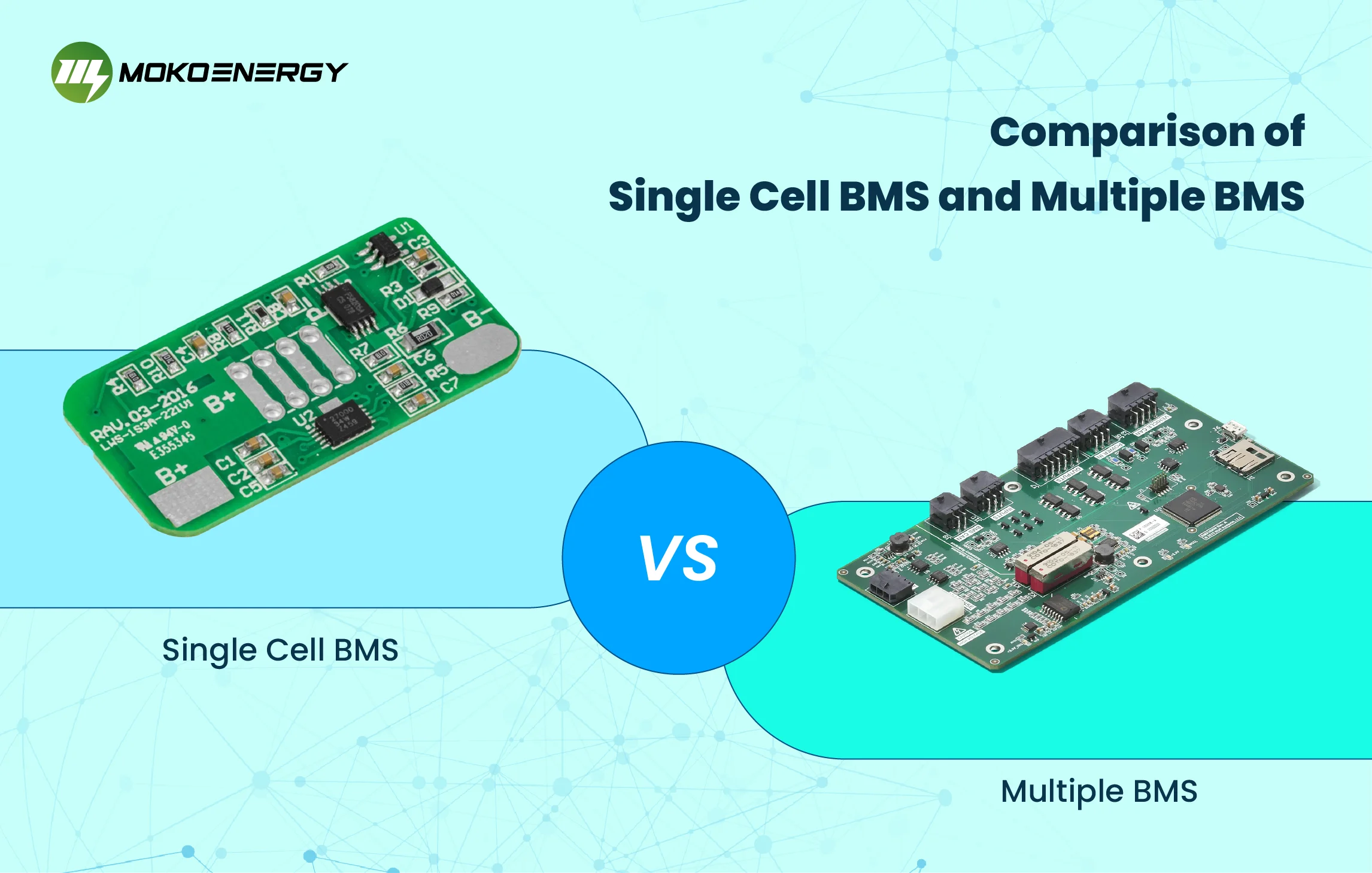Since we have discussed battery technology a lot, you must understand BMS well. And today I want to share something about single cell and multiple BMS. We all know that selecting the right battery management system (BMS) is critical for maximizing performance, safety, and longevity. Two primary options are existing: single cell BMS and multi-cell BMS. I will delve into their fundamental differences, advantages, disadvantages, and applications in this article, ultimately helping you decide which option suits your needs best.
I. What is a Single Cell BMS?
A single cell BMS is designed to control and monitor one battery cell. Its primary role is to monitor the vital parameters of battery for example voltage, temperature, and SoC. This system makes it possible for the cell to operate under established safety limits. In most cases, single cell BMS solutions are relatively smaller and less expensive to develop. This is why they are ideal for applications where managing individual cells suffices.
How Does It Work
The function of a single cell BMS is based primarily on the continuous monitoring and controlling of the individual cell performance level. The BMS includes voltage and temperature sensors that transmit the data to a microcontroller within the system. If it detects that the cell is approaching unsafe limits, such as over-voltage and over-temperature, the BMS can take protective measures. It will disconnect the load or give an alarm. This protective measure is very useful to ensure that the battery cell does not come to its physical limit as well as to maintain its durability.
Advantages
- Cost-Effectiveness:Single cell BMS units are cheaper than the multi-cell systems and hence suitable for budget-conscious applications.
- Simplicity: Single-cell BMS designs have slightly fewer components and are relatively simpler compared to their counterparts. Hence, they are relatively easier to implement, diagnose in case of failure, and maintain. Because of the relative simplicity of this structure, there tends to be quicker product delivery to the market.
- Compact Size: It occupies less space than a large BMS, which is beneficial for compact appliances such as those used in portable electronics.
Disadvantages
- Limited Capability: It can only manage one cell, which makes it unsuitable for larger battery packs that require simultaneous monitoring of multiple cells. This limitation may result in inefficiencies in larger applications.
- Less Comprehensive Monitoring: It cannot assess the overall health of a multi-cell arrangement, potentially leading to uneven aging or performance issues across a battery pack. This lack of insight can result in reduced overall system reliability.
II. What is a Multi-Cell BMS?
On the other hand, a multi-cell BMS is intended for the control of multiple battery cells simultaneously. It should be mentioned that such type of system is indispensable in applications related to larger battery configurations, for example, EVs and renewable energy storage systems. The multi-cell BMS is responsible for monitoring the individual cells and distributing the charge across the cells to improve the whole battery’s performance and durability.
How Multi-Cell BMS Works
A multi-cell BMS works towards a configuration of several channels where each cell is monitored for the said parameters. Another one can identify the state of charge, state of health, and temperature for every cell by making use of various algorithms. The BMS also can balance charge in the cell or correct for any anomalies it detects across the cells to ensure cells are performing at their best. This capability is especially significant in applications with high power consumption where reliability is paramount.
III. What is the Difference Between a Multi-Cell BMS and a Single-Cell BMS?
The primary distinction lies in the number of cells managed. A single BMS focuses exclusively on one battery cell, while a multiple BMS can handle multiple cells, facilitating advanced features such as cell balancing and comprehensive battery health monitoring. Multi-cell systems are inherently more complex, often incorporating sophisticated safety features, communication protocols, and advanced algorithms to ensure optimal performance across all cells.
IV. Single-Cell BMS vs. Multi-Cell BMS: Which is Better?
Determining whether a single-cell BMS or a multi-cell BMS is “better” largely depends on the specific requirements of your application.
Single-Cell BMS: Ideal for small-scale devices, low-power applications, or projects where budget constraints are paramount. If the application only requires monitoring and managing a single cell, this option is often sufficient and more economical.
Multi-Cell BMS: Essential for larger systems that demand robust monitoring, balancing, and performance optimization. Applications such as electric vehicles, grid energy storage, and industrial systems benefit significantly from the capabilities of a multi-cell BMS.
V. Applications for Single and Multi-Cell BMS
Single Cell BMS Applications
- Small Electronics: Devices such as smartphones, tablets, and wearables commonly use this units due to their compact size and lower power needs. Here, individual cell management is typically sufficient for performance and safety.
- Simple Battery Packs: DIY projects, portable gadgets, and low-power battery packs often utilize single cell BMS for ease of implementation and cost efficiency.
- Low-Power Devices: In applications where power consumption is minimal, such as sensors and small remote devices, a single cell BMS can effectively manage the energy requirements without the added complexity of a multi-cell system.

Multi-Cell BMS Applications
- Electric Vehicles (EVs): A multi-cell BMS is critical in EVs, where battery packs consist of multiple cells wired together. The BMS ensures that each cell remains balanced and operates efficiently, extending the vehicle’s range and lifespan.
- Renewable Energy Storage: In solar and wind energy systems, a multi-cell BMS manages large battery banks that store energy. The BMS balances the charge across cells, maximizing storage capacity and ensuring the safety of the system.
- High-Capacity Battery Packs: Industrial applications, such as robotics or backup power systems, often require robust battery management. A multi-cell BMS monitors the entire battery pack, ensuring reliability and performance under heavy loads.
Conclusion
When deciding between a single-cell BMS and a multi-cell BMS, it’s essential to consider the specific needs of your application. Each system offers unique benefits and limitations that can significantly influence performance, safety, and cost-effectiveness. A single cell BMS is often sufficient for smaller devices or low-power applications, providing an economical solution with straightforward implementation. On the other hand, a multi-cell BMS is indispensable for larger systems that require comprehensive monitoring, charge balancing, and performance optimization.
The right choice will depend on the complexity of your battery system and your specific operational needs. By understanding the capabilities, advantages, and limitations of each type of BMS, you can make an informed decision that enhances your battery performance and longevity, ensuring a successful application in today’s dynamic battery landscape.






